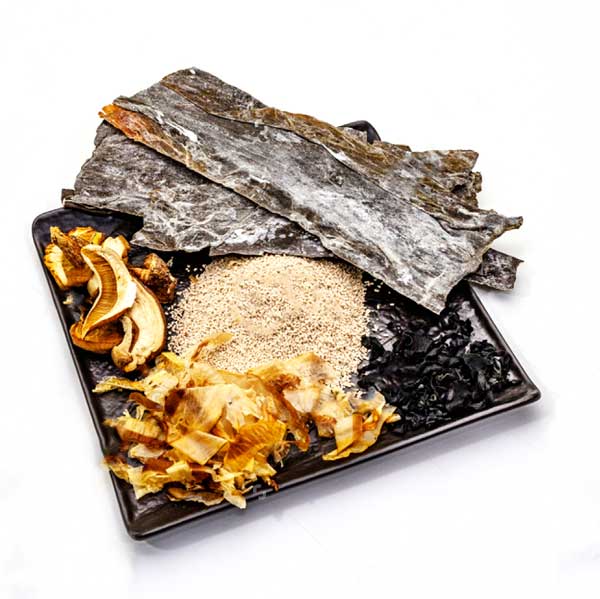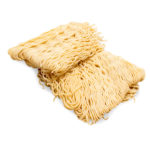Dashi (だし, 出汁) or Dashijiru (出し汁) is Japanese soup stock that is the backbone of many Japanese dishes. It is all-important and indispensable. You can trace its existence in Japanese daily cooking back to the Edo period (17th Century).
But what is dashi?

It is a soup stock made of infusions of foods that are rich in umami, including bonito fish flakes, dried kombu kelp seaweed, dried shiitake mushrooms, and dried whole sardines. Dashi makes up the liquid base in most savory Japanese dishes, including miso soup, udon, and ramen noodle dishes, and nabe stews. It is also used as a seasoning in dishes like tamagoyaki omelets and seaweed salads. Dashi is what gives these dishes that unique, slightly seafood-like, umami flavor that is most readily associated with Japanese cuisine.
Traditionally, families made their own dashi at home. In the process, a big pan of water is brought to the boil. Dried kombu seaweed and dried bonito (fish) flakes are steeped in the gently simmering water and strained. As with tea leaves, the dried seaweed and fish flakes can be reused — but will create a weaker ‘brew’. The stronger, first-brew dashi is known as ichiban dashi, and the second, weaker brew is called niban dashi.

What does dashi taste like?
All the dried ingredients that are making Japanese soup stock are rich in naturally occurring glutamates and provide intense flavor to the stock. Dashi creates a savory umami flavor from all these ingredients and you don’t need to season the food as much once you have a good stock.
With a distinctive sweet and savory note, the deep umami flavor is what set dashi apart from other stocks. When using dashi, it’s best to think of it in the context of other Japanese ingredients. Look to soy or miso rather than salt, mirin for sweetness, and everything from wakame (edible seaweed) to salmon and shrimp, as natural partners.
How do I use dashi?
The most common use for Japanese soup stock is in a bowl of delicious miso soup, the soup for the soul for the Japanese. If you wish to make a bowl of authentic Japanese miso soup try using dashi instead of substituting it with other broths such as vegetable or chicken broth. You will notice the difference right away!
Dashi is also a broth base in Japanese hot pots (e.g., Shabu Shabu), stews , simmered dishes , and noodle soup dishes (e.g., udon, soba, and ramen).
You can also use it as a seasoning liquid or add it to sauces to bring out the savory depth of the dishes. Since it is a clear umami-rich broth with a subtle aroma, dashi is really versatile and you can literally use it in many dishes that call for a touch of liquid.

Make a simple ramen with dashi
The broth can be used immediately, refrigerated for up to a week, or frozen for up to 3 months. Use it as a base for the noodles. We suggest boiling the noodles separately and adding to the steaming broth of dashi. If using our ramen kits – add 1/2 the seasoning packet for some added body to the stock. Top with your favorite veggies or protein.
Cooks note: For a vegetarian bowl, the dashi can be used once the kombu is removed. For a fuller flavor, steep the kombu overnight in the refrigerator before continuing with the recipe.
Ingredients:
- 1 or 2 Noodle packs from our Kaedama or ramen kits
- 2 cups water
- 2-inch piece kombu
- 1/2 cup loosely packed dried bonito flakes (katsuobushi), optional
- cooked spinach
- tofu
Preparation
- Warm the water and kombu over medium heat: Combine the water and kombu in a 1-quart saucepan and set over medium heat.
- Remove the kombu as the water comes to a boil: Remove the kombu from the water just before it comes to a full boil. (Boiling the kombu can make the broth bitter and a bit slimy.) – at this point its ready if you are a vegetarian. (just let it cool)
- Add the bonito flakes and simmer: Add the bonito flakes, if using, and let the water come to a rapid simmer. Continue simmering for about 1 minute.
- Steep the bonito flakes off the heat: Remove the pan from heat and let the bonito steep in the broth for an additional 5 minutes.
- Strain the broth: Strain the bonito flakes from the both. Add additional water, pouring through the strained bonito, if needed to make 2 cups.
Assemble the bowl with noodles, tofu and spinach. Pour the heated dashi over the top and enjoy!
Do you have a recipe to share? TAG us when you use Hakubaku USA products with the tag @hakubakuus on all socials- and we will post a link and your recipe!


